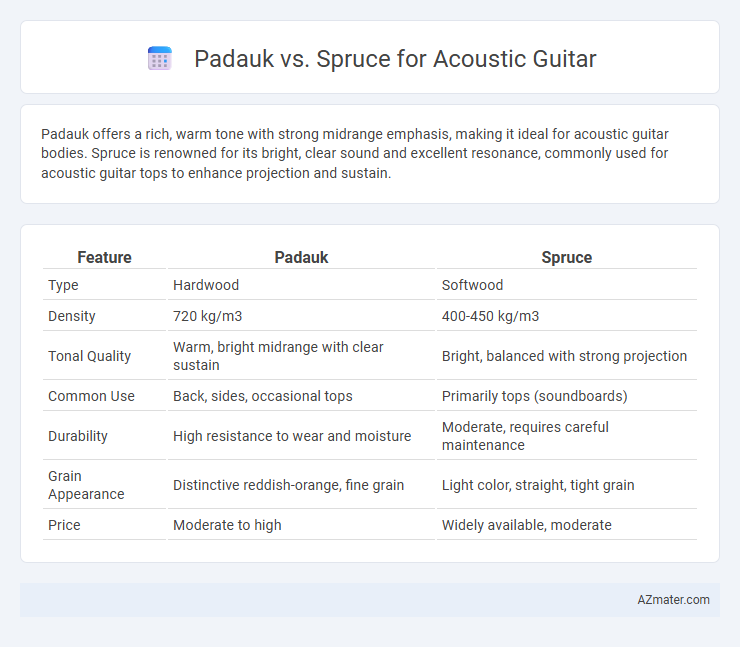Padauk offers a rich, warm tone with strong midrange emphasis, making it ideal for acoustic guitar bodies. Spruce is renowned for its bright, clear sound and excellent resonance, commonly used for acoustic guitar tops to enhance projection and sustain.
Table of Comparison
| Feature | Padauk | Spruce |
|---|---|---|
| Type | Hardwood | Softwood |
| Density | 720 kg/m3 | 400-450 kg/m3 |
| Tonal Quality | Warm, bright midrange with clear sustain | Bright, balanced with strong projection |
| Common Use | Back, sides, occasional tops | Primarily tops (soundboards) |
| Durability | High resistance to wear and moisture | Moderate, requires careful maintenance |
| Grain Appearance | Distinctive reddish-orange, fine grain | Light color, straight, tight grain |
| Price | Moderate to high | Widely available, moderate |
Introduction to Padauk and Spruce Tonewoods
Padauk is a dense hardwood known for its warm, balanced tone with pronounced midrange frequencies, often producing a rich, full-bodied sound ideal for acoustic guitar backs and sides. Spruce, particularly Sitka or Engelmann varieties, is prized for its lightweight strength and bright, resonant qualities, delivering clear, dynamic projection and excellent responsiveness as a top wood. Combining Padauk's warmth with Spruce's clarity can result in a well-rounded acoustic guitar tone that suits various playing styles.
Origins and Botanical Differences
Padauk originates primarily from tropical regions in Africa and Asia, known for its vibrant reddish-orange heartwood and dense grain structure that enhances sustain in acoustic guitars. Spruce, commonly sourced from North America's Pacific Coast or European forests, features a pale, creamy color with a tight, straight grain, prized for its exceptional stiffness-to-weight ratio, providing bright, clear tone and dynamic responsiveness. These botanical distinctions affect tonal qualities, with Padauk offering warmth and rich midrange, while Spruce delivers clarity and projection favored in acoustic guitar soundboards.
Appearance and Aesthetics
Padauk showcases a rich, vibrant reddish-orange hue with distinctive grain patterns that deepen in color over time, offering a warm and exotic visual appeal for acoustic guitars. Spruce is prized for its light, creamy color and fine, straight grain, providing a classic, elegant look that enhances the guitar's traditional aesthetic. The contrasting tones of Padauk and Spruce influence the guitar's overall style, making Padauk ideal for bold designs while Spruce suits more understated, timeless appearances.
Tonal Characteristics Comparison
Padauk wood offers a warm, rich tone with pronounced midrange frequencies and a strong, balanced sustain, making it ideal for players seeking a full-bodied sound. Spruce, known for its bright, clear, and articulate tonal characteristics, provides excellent projection and a wide dynamic range favored in acoustic guitars. The contrast between Padauk's warmth and Spruce's clarity allows musicians to choose based on preferences for either mellow depth or crisp definition in their guitar's voice.
Durability and Stability
Padauk offers impressive durability and resistance to moisture, making it highly stable for acoustic guitar construction, especially in humid conditions. Spruce, though less dense, is prized for its balanced strength-to-weight ratio, providing reliable stability with a lighter feel but requiring proper care to avoid warping. Both woods deliver long-lasting performance, with Padauk excelling in toughness and Spruce favored for its consistent structural integrity over time.
Workability for Luthiers
Padauk offers excellent workability for luthiers due to its hardness and stability, allowing precise shaping and fine detail carving without significant wear on tools. Spruce, known for its softness and lightweight nature, provides easier cutting and sanding, making it favorable for delicate bracing and top plates but may require careful handling to avoid dents. Both woods require different skill approaches: Padauk demands robust tools and patience, while Spruce benefits from gentle techniques to maximize fine craftsmanship in acoustic guitar construction.
Price and Availability
Padauk offers a unique tonal character often found in mid-range acoustic guitars, with prices generally slightly above entry-level models due to its exotic wood status and moderate availability. Spruce top guitars dominate the market, favored for their bright, resonant sound and wide availability, which keeps prices competitive from budget to premium levels. Buyers seeking affordability and easy access might prefer spruce, while those valuing distinct tone with moderate market presence may choose padauk.
Impact on Guitar Sound Projection
Padauk wood enhances acoustic guitar sound projection with its dense grain structure, producing a warm, rich tone and strong midrange frequencies that carry well in live settings. Spruce, known for its lightweight and resonant qualities, offers superior sound projection with bright, clear highs and excellent dynamic responsiveness, making it ideal for volume and articulation. The choice between Padauk and Spruce significantly affects the guitar's projection style, with Padauk delivering robust, full-bodied sound and Spruce providing sharp, penetrating clarity.
Popular Uses in Acoustic Guitar Building
Padauk wood is favored in acoustic guitar building for its vibrant reddish hue and strong midrange tones, making it popular for back and sides that project clear, balanced sound. Spruce, particularly Sitka spruce, is widely used for guitar tops due to its lightweight strength and excellent resonance, providing a bright, dynamic tone with great responsiveness. Many luthiers combine spruce tops with padauk back and sides to achieve a rich tonal blend, balancing warmth and clarity in acoustic guitars.
Choosing the Right Wood for Your Playing Style
Padauk offers a warm, midrange-focused tone with strong sustain, ideal for fingerstyle and blues players seeking rich, resonant sound. Spruce, renowned for its bright, clear, and dynamic projection, suits strummers and flatpickers who need volume and articulation. Matching padauk's dense, resonant properties or spruce's lightweight, responsive qualities to your playing style enhances tonal clarity and performance precision.

Infographic: Padauk vs Spruce for Acoustic Guitar
 azmater.com
azmater.com